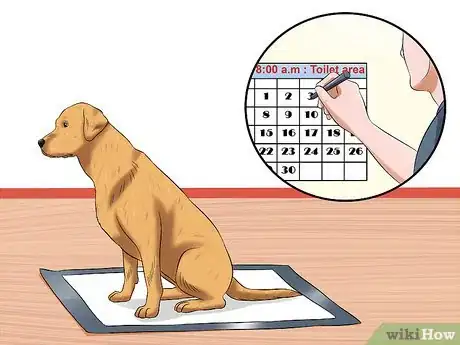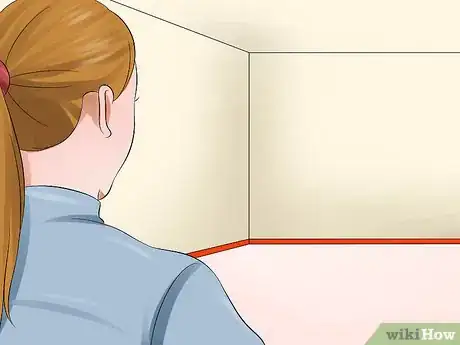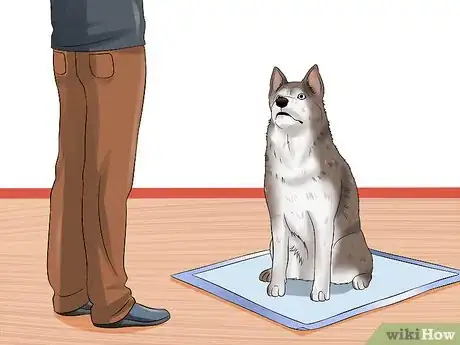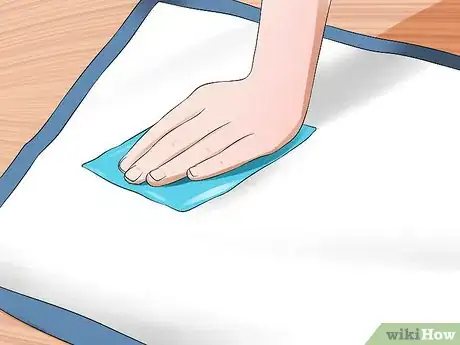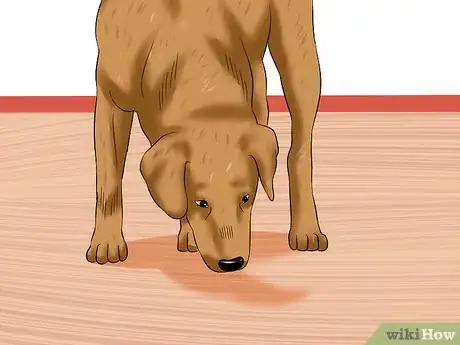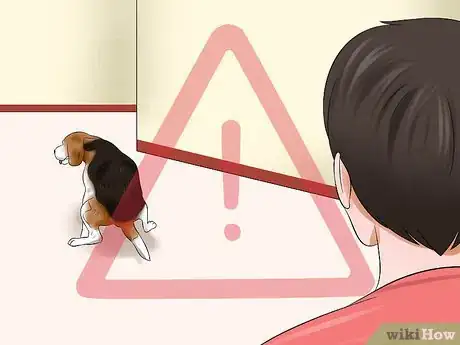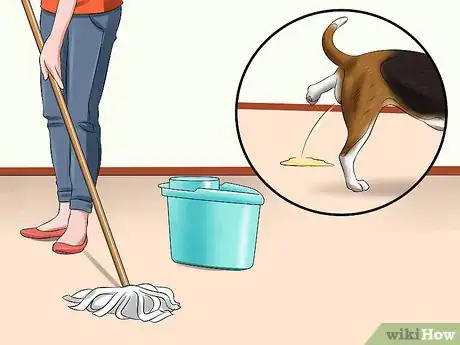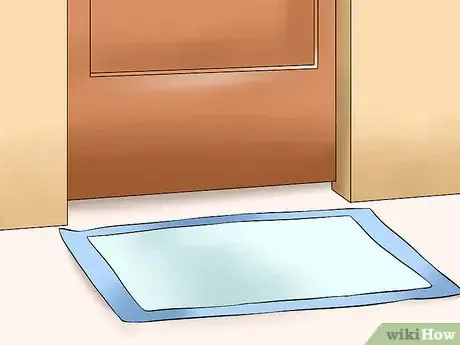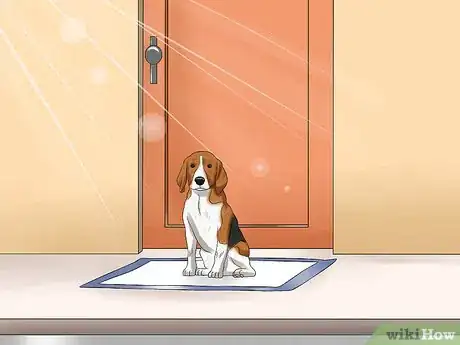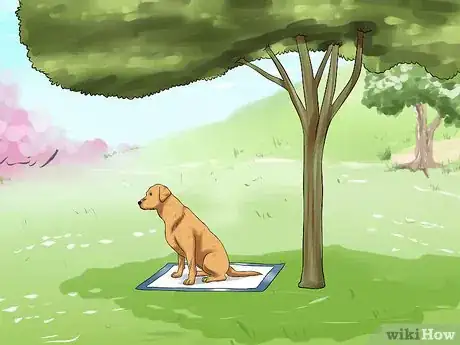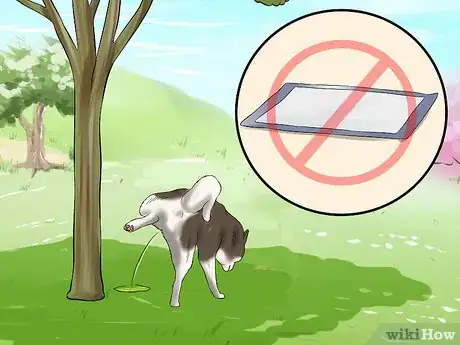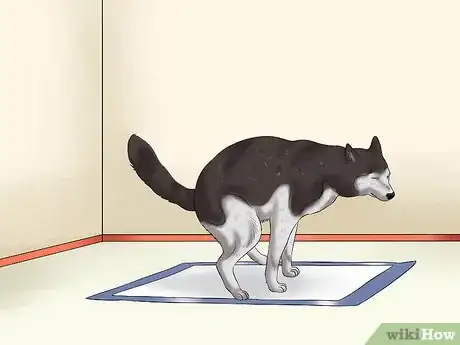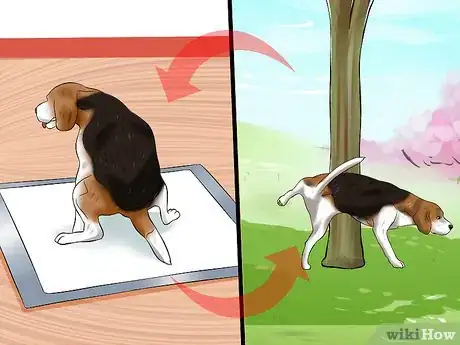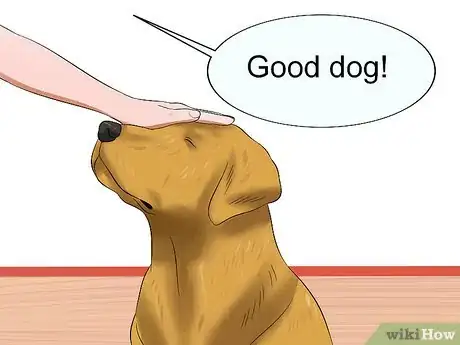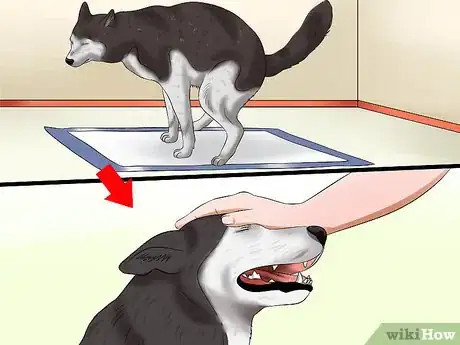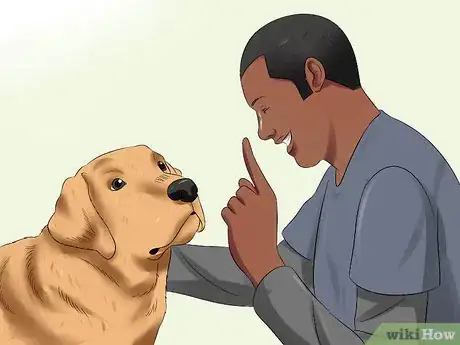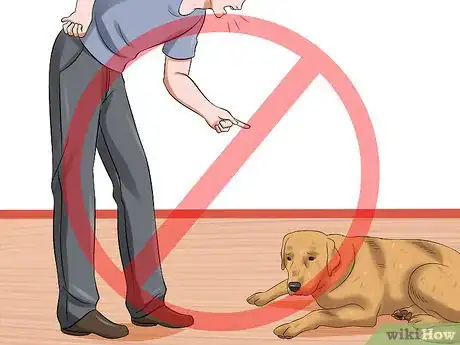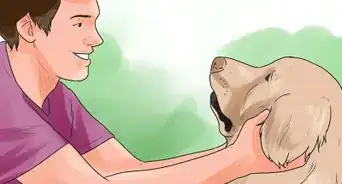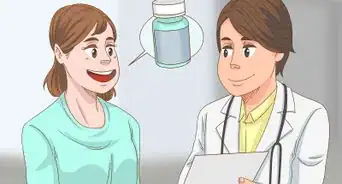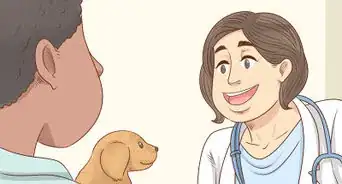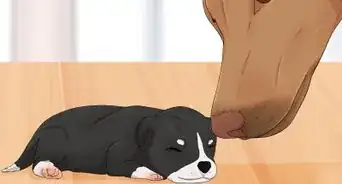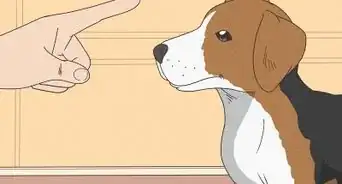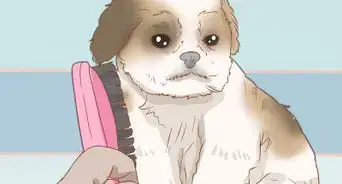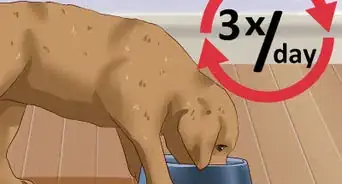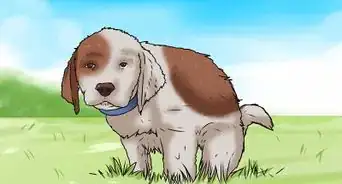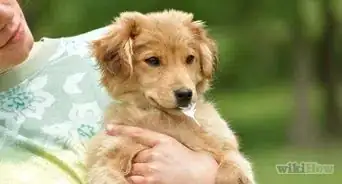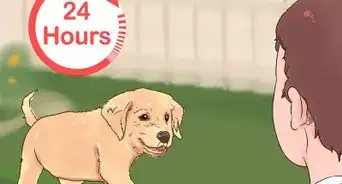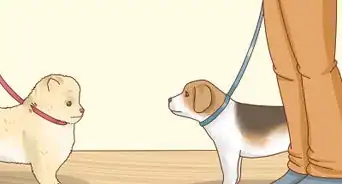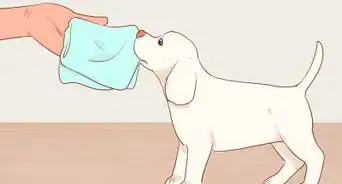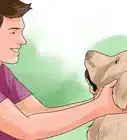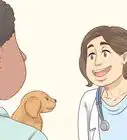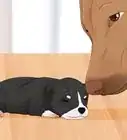This article was co-authored by Colleen Demling-Riley, CPDT-KA, CBCC-KA, CDBC. Colleen Demling-Riley (CPDT-KA, CBCC-KA, CDBC) is a Canine Behavior Consultant and the Founder of Pawtopia Dog Training. With more than 20 years of experience, she specializes in creating and customizing dog management programs for dog owners. She is a Certified Pet Dog Trainer-Knowledge Assessed, Certified Behavior Consultant Canine-Knowledge Assessed, Certified Dog Behavior Consultant, and American Kennel Club Canine Good Citizen Evaluator. Colleen is a member of the International Association of Canine Professionals and has been a featured expert in national media including the New York Times, Woman’s Day, Readers Digest, Cosmopolitan, and Yahoo.com.
There are 10 references cited in this article, which can be found at the bottom of the page.
wikiHow marks an article as reader-approved once it receives enough positive feedback. In this case, 100% of readers who voted found the article helpful, earning it our reader-approved status.
This article has been viewed 400,661 times.
If you live in an apartment, you might want to start house training your dog with puppy pads. This way, your dog can learn to relieve himself in a designated spot in your house. But you might also find it useful to try outdoor training for him. This will give you the flexibility to have your dog pee inside when you’re not at home, and go outside when you are home.
Steps
Following a Consistent Routine with Puppy Pads
-
1Follow a 24-hour schedule. In order to house train your dog, you need to strictly follow a schedule. This will establish a routine for both you and your dog. Your dog needs to go out first thing in the morning, after meals and play times, and before bedtime.[1] Every moment should be accounted for. The schedule will vary depending on your dog's age — figure your dog can hold their bladder for one hour for each month of age, plus one hour. So a two-month-old pup can wait three hours max; a three-month-old pup can wait four hours max, and so on. This is a sample schedule for someone who is home all day and a dog who is about three months old:
- 7:00 a.m.: Wake up and take dog to the toileting area
- 7:30 a.m.: Feed (puppy should always have access to water during the day)
- 7:45 a.m.: Toilet area (Always after eating/drinking/napping/playtime)
- 8:00 a.m.: Supervised free time
- 8:45 a.m.: Crate confinement
- 10:45 a.m.: Toilet area
- 11:00 a.m.: Supervised free time
- 12:30 p.m.: Feed
- 12:45 p.m.: Toilet area (Always after eating/drinking/napping/playtime)
- 1:00 p.m.: Supervised free time
- 1:45 p.m.: Crate confinement
- 3:45 p.m.: Toilet area
- 4:00 p.m.: Supervised free time
- 6:00 p.m.: Feed
- 6:15 p.m: Toilet area
- 6:30 p.m.: Supervised free time
- 9:00 p.m.: Remove water
- 9:15 p.m.: Supervised free time
- 11:00 p.m.: Toilet area and crate confinement overnight
-
2Choose a designated spot for indoor toileting. Select a place in your house that is suitable for your dog’s toileting. Ideally, this is a place with easy-to-clean floors such as a bathroom or kitchen area. Place a puppy pad here.[2]
- You need to be the one to choose the toilet spot. You need to be okay with its location when it’s indoors. For example, you might not want to put a puppy pad in your kitchen if you don’t want to have dog poo and pee near where you cook and eat.[3]
- Use consistent language to refer to this place. For example, when your dog reaches this spot, say, “Go potty,” or use a similar verbal cue. Then your dog will associate this spot with toileting.
Advertisement -
3Take your dog to the potty spot. At a scheduled potty time, or when you recognize your dog’s cues for needing to relieve himself, take him to the puppy pad.[4]
- You might want to take him on a leash, even if he’s inside. This will get him used to the leash, which you may need when you start your outdoor potty training.
-
4Change the puppy pad frequently. Make sure to clean up after your dog relieves himself. Dogs will want to relieve themselves where they smell their urine, so you should leave a used puppy pad with a bit of urine underneath a clean puppy pad. Remove all feces from the area after the dog relieves himself.[5]
-
5Learn your dog’s signs. Pay close attention to your dog so that you learn when he has to go.[6] This might include the dog walking around stiffly or in circles, sniffing the floor like he’s searching for somewhere to pee, or letting his tail rest in a strange position.
- If your dog looks like he needs to relieve himself, take him out to his designated spot right away. Do this even if you’re not at your scheduled potty break.[7]
-
6Keep a close eye on your dog at all times. You need to keep a vigilant eye on your dog whenever he is out of his crate. Even if he’s in the kitchen during his free time, you still need to watch him. This will ensure that you catch him before he has an accident. It’s imperative during this time that your dog associates toileting with going to his puppy pad.
- You might consider tethering your dog to your waist with a leash when he is out of his crate. This way, you will be sure to keep him very close to you. You can track his movements more closely.[8]
-
7Clean up accidents immediately. If your dog has an accident in the house, clean it up as soon as possible. You don’t want your dog relieving himself anywhere but on the puppy pad.
- Don’t use an ammonia-based cleaner. Urine has ammonia in it, so your dog might associate the cleaner’s smell with urinating. Instead, use an enzymatic cleaner on soiled areas.[9]
- Don’t punish your dog for having an accident.
Introducing Outdoor Training
-
1Start moving the puppy pad towards the door. Your goal is to get your dog out the door when he needs to relieve himself. When your dog can consistently use the puppy pad area, then you can start integrating outdoor training into the mix. Move the puppy pad a little closer to the door every day. Do this incrementally, moving it a few feet every day.
- Praise the dog every time he uses the puppy pad. Give him a pat and use a friendly voice.
- If your dog is having accidents after you’ve moved the pad, you may be moving too quickly. Move the pad back and wait another day before moving it again.[10]
-
2
-
3Place the pad near the outdoor toilet area. Plan a space where you would like your dog to relieve himself. This might be a patch of grass or near the base of a tree. When your dog needs to go out, bring a pad with you so that your dog will associate the outdoor place with the pad.[13]
-
4Remove the pad altogether. Once your dog is using the pad outside, you can stop setting out the pad for him. He will use the outdoor patch instead.
-
5Add another puppy pad in the indoor toileting area. If you want your dog to have the option of relieving himself indoors or outdoors, then you can set up the toileting area inside again.
-
6Alternate between the indoor and outdoor potty spots. Keep your dog familiar with both the indoor and outdoor potty spots by taking him to each one. Alternate between both for a couple of weeks so that he is accustomed to using both.
Giving Praise to Your Dog
-
1Give lots of praise. When your dog has relieved himself, either indoors or outdoors, give him lots of attention and pats. Say, “Good dog!” and other praise. Have a little celebration with your dog. This lets your dog know that its behavior is remarkable and deserves praise.[14]
-
2Make sure to time your praise appropriately. When your dog has finished relieving himself, give him praise right away. You want to be sure that he associates the praise with the action that he just did. Otherwise, he might get confused about what he’s being praised for.
-
3Keep your voice friendly. Don’t use a harsh tone with your dog while you’re house training him. You don’t want him to feel scared or anxious about going outside or relieving himself.
- Don’t yell at your dog if he has an accident.
-
4Don’t punish your dog for accidents. Your dog is learning how to follow your instructions. Be patient with him. Don’t rub his face in his waste.[15] Don’t yell or shout at your dog. Don’t hit your dog. If you’re not patient and friendly, your dog may associate fear and punishment with toileting.
- If you catch your dog in the middle of an accident, make a loud noise or clap to startle him. Then he will stop urinating or defecating, and you can take him to his designated toileting area to finish up.
Expert Q&A
Did you know you can get expert answers for this article?
Unlock expert answers by supporting wikiHow
-
QuestionMy 5-month Pomeranian uses her pad, but when I let her run free she pees wherever she likes. What should I do?
 Pippa Elliott, MRCVSDr. Elliott, BVMS, MRCVS is a veterinarian with over 30 years of experience in veterinary surgery and companion animal practice. She graduated from the University of Glasgow in 1987 with a degree in veterinary medicine and surgery. She has worked at the same animal clinic in her hometown for over 20 years.
Pippa Elliott, MRCVSDr. Elliott, BVMS, MRCVS is a veterinarian with over 30 years of experience in veterinary surgery and companion animal practice. She graduated from the University of Glasgow in 1987 with a degree in veterinary medicine and surgery. She has worked at the same animal clinic in her hometown for over 20 years.
Veterinarian She is only partially trained and whilst she realizes the pad is a toilet, she also thinks the rest of the house is a toilet, too. Keep her on a lead in the house so that you can spot tell tale signs of sniffing to toilet and then put her straight onto the pad when she shows signs of wanting to relieve herself. Then give lots of praise when she goes. You also need to thoroughly clean all areas where she has peed so there are no scent markers to draw her back.
She is only partially trained and whilst she realizes the pad is a toilet, she also thinks the rest of the house is a toilet, too. Keep her on a lead in the house so that you can spot tell tale signs of sniffing to toilet and then put her straight onto the pad when she shows signs of wanting to relieve herself. Then give lots of praise when she goes. You also need to thoroughly clean all areas where she has peed so there are no scent markers to draw her back. -
QuestionIf my puppy doesn't go at the scheduled time, say 12:30, should he wait in the crate until the next scheduled break at 5:30?
 Pippa Elliott, MRCVSDr. Elliott, BVMS, MRCVS is a veterinarian with over 30 years of experience in veterinary surgery and companion animal practice. She graduated from the University of Glasgow in 1987 with a degree in veterinary medicine and surgery. She has worked at the same animal clinic in her hometown for over 20 years.
Pippa Elliott, MRCVSDr. Elliott, BVMS, MRCVS is a veterinarian with over 30 years of experience in veterinary surgery and companion animal practice. She graduated from the University of Glasgow in 1987 with a degree in veterinary medicine and surgery. She has worked at the same animal clinic in her hometown for over 20 years.
Veterinarian The schedule is a guideline rather than a hard and fast rule. The principle you are following is to confine the puppy when you can't be there, so they are less likely to have accidents. If you suspect the puppy needs to toilet then remove them from the crate and put on the toilet area. If they don't toilet within five minutes then return them to the crate. Or, if the puppy cries in the crate and you think they need the toilet, wait until they are quiet and then pop them on the toilet spot.
The schedule is a guideline rather than a hard and fast rule. The principle you are following is to confine the puppy when you can't be there, so they are less likely to have accidents. If you suspect the puppy needs to toilet then remove them from the crate and put on the toilet area. If they don't toilet within five minutes then return them to the crate. Or, if the puppy cries in the crate and you think they need the toilet, wait until they are quiet and then pop them on the toilet spot.
Warnings
- If your dog is having accidents and he doesn’t seem to get successfully housebroken, talk with your vet. Then you will be able to rule out medical issues and emotional issues that might be affecting your dog.[16]⧼thumbs_response⧽
References
- ↑ Colleen Demling-Riley, CPDT-KA, CBCC-KA, CDBC. Canine Behavior Consultant. Expert Interview. 25 March 2022.
- ↑ Colleen Demling-Riley, CPDT-KA, CBCC-KA, CDBC. Canine Behavior Consultant. Expert Interview. 25 March 2022.
- ↑ http://thehousebreakingbible.com/wp/training-indoor-potty-training/
- ↑ Colleen Demling-Riley, CPDT-KA, CBCC-KA, CDBC. Canine Behavior Consultant. Expert Interview. 25 March 2022.
- ↑ http://thehousebreakingbible.com/wp/training-indoor-potty-training-method1/
- ↑ Colleen Demling-Riley, CPDT-KA, CBCC-KA, CDBC. Canine Behavior Consultant. Expert Interview. 25 March 2022.
- ↑ http://www.humanesociety.org/animals/dogs/tips/housetraining_puppies.html
- ↑ http://thehousebreakingbible.com/wp/training-umbilical-cord-training/
- ↑ https://www.aspca.org/pet-care/virtual-pet-behaviorist/dog-behavior/house-training-your-puppy
- ↑ http://www.dogtrainingbasics.com/transitioning-potty-pad-outside/
- ↑ Colleen Demling-Riley, CPDT-KA, CBCC-KA, CDBC. Canine Behavior Consultant. Expert Interview. 25 March 2022.
- ↑ http://www.dogtrainingbasics.com/transitioning-potty-pad-outside
- ↑ Colleen Demling-Riley, CPDT-KA, CBCC-KA, CDBC. Canine Behavior Consultant. Expert Interview. 25 March 2022.
- ↑ https://www.cesarsway.com/housebreaking-your-puppy-dos-and-donts/
- ↑ https://www.aspca.org/pet-care/virtual-pet-behaviorist/dog-behavior/house-training-your-puppy
- ↑ http://www.americanhumane.org/animals/adoption-pet-care/dog-behavior/housetraining-puppies-dogs.html
About This Article
To use puppy pads and outdoor potty training together, start by establishing a regular bathroom schedule. When it’s time for your dog to go to the bathroom, bring it over to the puppy pad and say “Go potty” so it associates this spot with toileting. When your dog starts using the puppy pad consistently, begin moving the pad a little closer to the door every day, eventually moving the pad outside. Once your dog gets the hang of using the pad outside, you can stop setting out the pads. To learn how to praise your dog for going to the bathroom in the right spot, keep reading!
